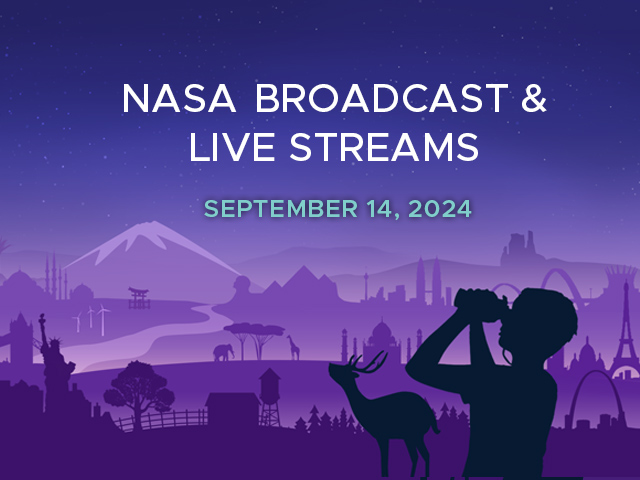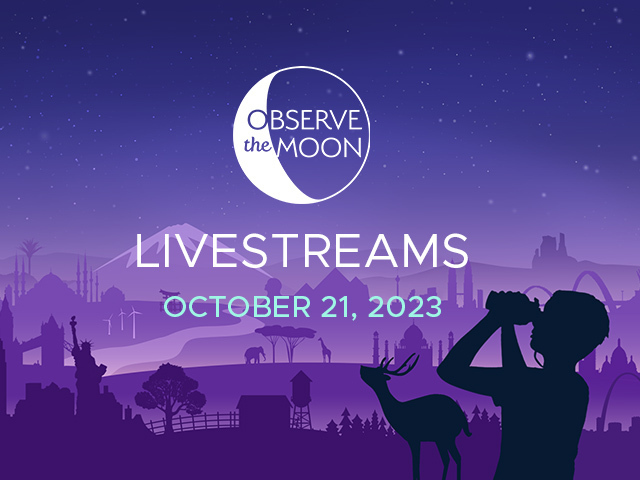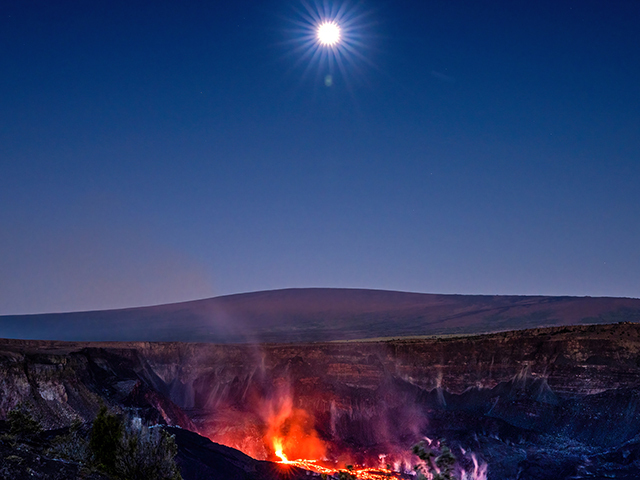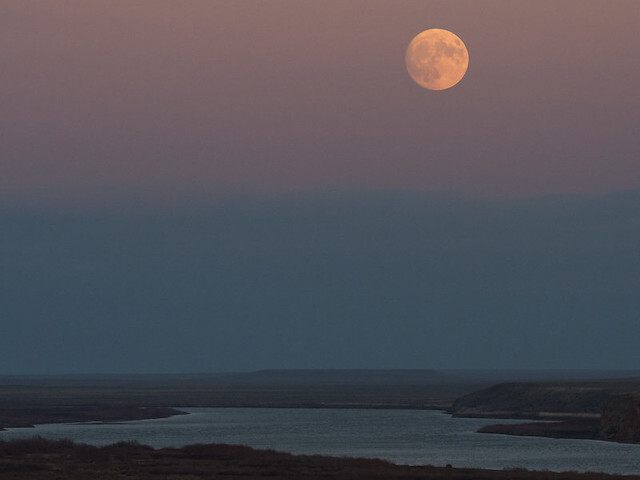News | December 11, 2016
A Supermoon and Then Some
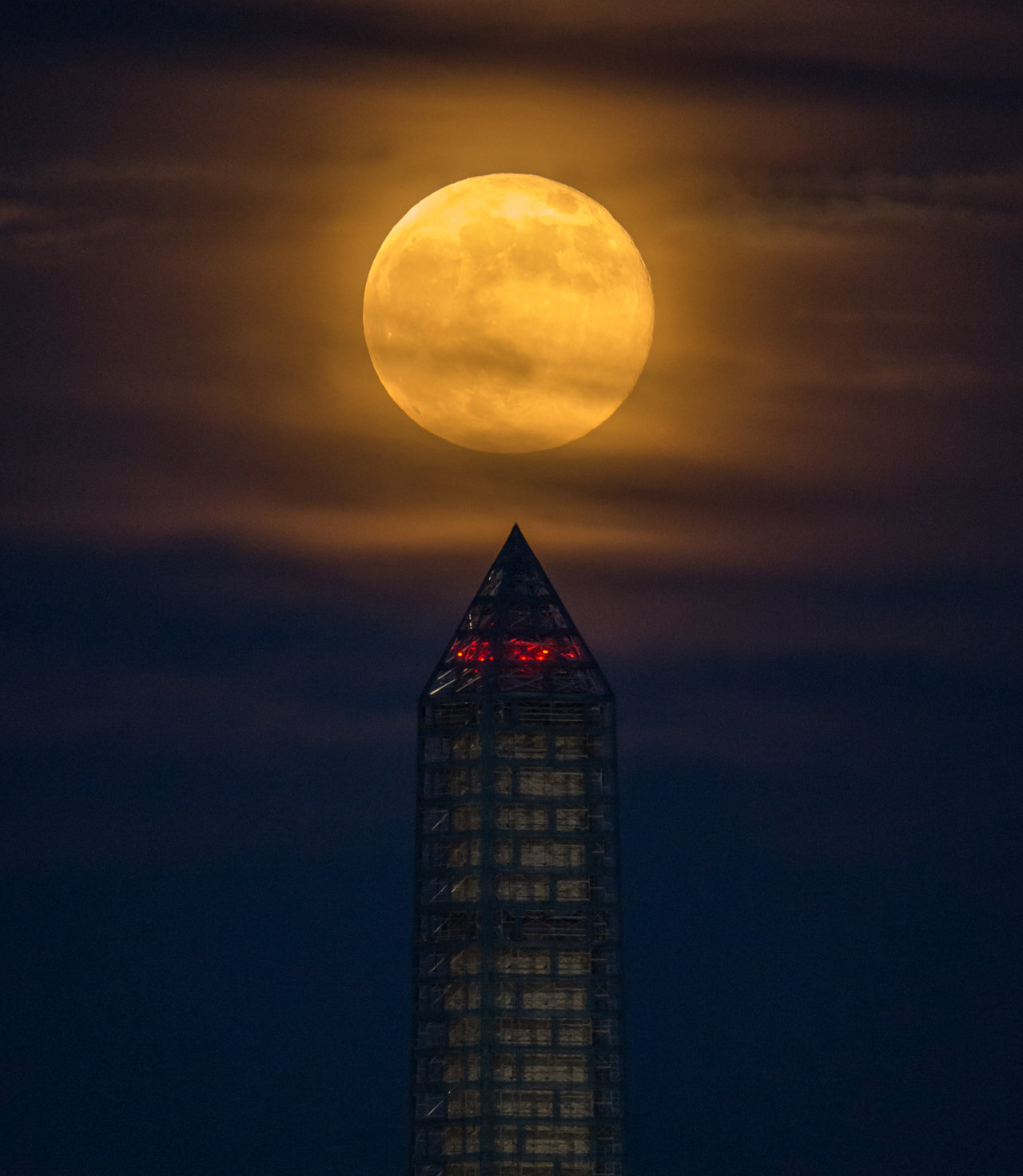
The next full Moon will be on Tuesday evening, December 13, 2016, appearing "opposite" the Sun (in Earth-based longitude) at 7:05 PM EST. The Moon will appear full for about three days around this time, from Monday evening through Thursday morning.
As the last full Moon of Fall, this Moon is known as the Frost Moon or the Moon Before Yule. The Maine Farmer's Almanac first published Indian names for the full Moons in the 1930's, and according to this almanac, the Native American name for this full Moon was the Frost Moon, as frosts began to occur at the end of Fall. Europeans called this the "Moon before Yule" (Yule is an old northern European winter festival that is now associated with Christmas).
As the full Moon closest to the Winter Solstice, another European name for this Moon is the Long Night Moon. Since the plane of the Moon's orbit around the Earth is nearly parallel with the plane of the Earth's orbit around the Sun, when the path of the Sun appears lowest in the sky for the year (near the Winter solstice) the path of the full Moon (opposite the Sun) appears highest in the sky. For the Washington, DC, area, on Tuesday evening, December 13, 2016, sunset will be at 4:47 PM, the full Moon will rise at 4:58 PM (about 11 minutes after sunset), the Moon will reach its highest point of 69.4 degrees above the horizon on Wednesday morning at 12:17 AM, sunrise will be at 7:19 AM, and the Moon will set 19 minutes later at 7:38 AM EST. The Moon will be in the sky for 14 hours 40 minutes, with all but 19 minutes of this when the Sun is down, making this the longest full Moon of the year.
Since this full Moon occurs just 12 hours after perigee (the Moon's closest approach to the Earth in its orbit) this full Moon is also a "SuperMoon" (although not quite as "super" as last month's "SuperMoon"). For this perigee the Moon will be 13% closer to Earth than it will be when at apogee at the end of December, making the light of the full Moon 28% brighter than it would be if the full Moon were at apogee. By comparison, last month the Moon at perigee was 14% closer than at apogee, with the moonlight 30% brighter.
In lunisolar calendars the months change with the new Moon and full Moons fall in the middle of the lunar months. This full Moon is the middle of the eleventh month of the Chinese calendar, Kislev (sometimes known as the month of dreams) in the Hebrew calendar (Hanukkah starts on the 25th day of Kislev), and Margashirsha in the Hindu calendar.
In the Islamic calendar the months start with the first sighting of the waxing crescent Moon a few days after the New Moon. This full Moon is near the middle of Rabi' al-awwal, the third month of the calendar. In this month most Muslims celebrate Mawlid, the birthday of the prophet Muhammad, although different denominations celebrate different days of the month.
As usual, the wearing of suitably celebratory celestial attire is encouraged in honor of the full Moon.
As for other celestial events between now and the full Moon after next:
At the end of autumn and beginning of winter the daily periods of sunlight reach their shortest, although for reasons I won't go into here but can send you upon request, the solar days (for example, as measured from solar noon to solar noon) are actually at their longest. Because the solar days are longer than 24 hours, the earliest sunsets of the year occur before the solstice and the latest sunrises of the year (ignoring daylight savings time) occur after the solstice.
For the Washington, DC area (I use the location of NASA Headquarters for these calculations), the earliest sunset of the year was a tie between December 6 and 7, 2016, with sunset at 4:45:52 PM EST. On the day of the December full Moon, morning twilight will begin at 6:15 AM, sunrise will be at 7:18 AM, the Sun will reach a maximum altitude of 27.9 degrees at 12:03 PM, sunset will have already started to get later again and will be 4:47 PM, and evening twilight will end at 5:50 PM EST. The Winter Solstice, the astronomical end of Autumn and start of Winter, will be on Wednesday morning, December 21, 2016, and this will be the day with the shortest period of sunlight for the year (9 hours, 26 minutes, 15 seconds for the Washington, DC area). The longest solar day of the year (as measured from solar noon to solar noon) will be the next day, Thursday, December 22, 2016 (29.8 seconds longer than 24 hours). Ignoring Daylight Savings Time, the latest sunrise this winter (again for the Washington, DC area) is a tie between January 4 and 5, 2017, with sunrise at 7:26:56 AM EST. By the time of the January full Moon, morning twilight will begin at 6:24 AM, sunrise will be at 7:26 AM, the Sun will reach a maximum altitude of 29.6 degrees at 12:17 PM, sunset will be at 5:07 PM, and evening twilight will end at 6:10 PM EST.
On the evening of the December full Moon, as evening twilight ends (at 5:50 PM EST for the Washington, DC area), the planet Mercury will appear about 3 degrees above the horizon in the west-southwest. Venus as the evening star continues to brighten and appears about 21 degrees above the horizon in the southwest. Mars appears about 34 degrees above the horizon in the south-southwest. The bright stars of the local arm of our home galaxy will be rising in the east and by midnight they will be nearly directly overhead. Over the next few weeks Mercury will begin to shift towards the Sun and become harder to see in the evening sky. Venus will continue to brighten and will appear to shift towards Mars.
On the morning of the December full Moon, as morning twilight begins, the bright planet Jupiter will appear about 49 degrees above the horizon in the south-southeast (having risen around 2:04 AM EST for the Washington, DC area). The bright star near Jupiter is Spica. Later in December the planet Saturn will appear to emerge from the glow of the Sun in the east-southeast just before dawn, having passed around the far side of the Sun as seen from the Earth on December 10. Around New Year's, the planet Mercury will appear to emerge in the east-southeast just before dawn, having passed between the Earth and the Sun on December 28, 2016.
The annual Geminid meteor shower, caused by debris from the comet 3200 Phaethon hitting the Earth's atmosphere at 35 km/sec (78,000 miles per hour), will continue to be active until December 16, 2016, peaking early in the morning of December 13, 2016, when the light of the almost full Moon will interfere.
The annual Ursid meteor shower, caused by debris from the comet 8P/Tuttle hitting the Earth's atmosphere at 33 km/sec (74,000 miles per hour), will be active from December 17 to 26, 2016, peaking early in the morning of December 22, 2016. This shower is not expected to produce many visible meteors this year (about 10 per hour), and the light of the waning crescent Moon will interfere.
The annual Quadrantid meteor shower, caused by debris from the object 2003 EH1 hitting the Earth's atmosphere at 41 km/sec (92,000 miles per hour), will be active from January 1 to 6, peaking in the morning of January 3, 2017. The Quadrantids are a fairly narrow shower that can have an intense peak, but this year the peak is predicted to be around 9 AM EST, well after sunrise. The parent body for this meteor shower, 2003 EH1, appears to be an extinct comet and may have broken off from the comet C/1490 Y1 observed by Chinese, Japanese, and Korean astronomers over 500 years ago.
Even though they usually are not visible, I include in these Moon missives information about Near Earth Objects (mostly asteroids) that pass near the Earth, because I find it interesting that we have discovered so many. I used to list passages within 15 lunar distances, but we are finding so many that as of November 2016 I am only listing passages within 10 lunar distances. You will also notice that I list a lot more over the first few days than I show later, but this is because we find many of these objects just before they pass the Earth (and sometime just after the pass).
On Sunday evening, December 11, 2016 at 8:31 PM EST (2016-Dec-12 01:31 UTC), Near Earth Object (2016 XA), between 18 and 41 meters (60 to 135 feet) in diameter, will pass the Earth at 7.2 lunar distances traveling at 11.06 kilometers per second (24,744 miles per hour).
Monday evening, December 12, 2016, at 6:27 PM EST, the Moon will be at perigee, its closest to the Earth for this orbit. At 358,461 km, the Moon will be 13% closer than it will be when it is at apogee at the end of December.
On Monday evening, December 12, 2016 at 7:18 PM EST (2016-Dec-13 00:18 UTC), Near Earth Object (2016 XW20), between 13 and 28 meters (42 to 93 feet) in diameter, will pass the Earth at 1.8 lunar distances traveling at 8.42 kilometers per second (18,832 miles per hour).
On Monday evening, December 12, 2016, into Tuesday morning, December 13, 2016, the nearly full perigee Moon will appear quite near the bright star Aldebaran. For the Washington, DC area, evening twilight will end Tuesday at 5:50 PM, the Moon will pass in front of Aldebaran from about 11:07 PM until about 12:20 AM, right around when the Moon will be at its highest in the sky for the night (11:15 PM). Aldebaran will set Tuesday morning just a few minutes before morning twilight begins at 6:15 AM, with the Moon setting at 6:31 AM EST.
On Tuesday afternoon, December 13, 2016 at about 2:45 PM EST (2016-Dec-13 19:45 UTC with 14 minutes uncertainty), Near Earth Object (2015 YA), between 9 and 20 meters (29 to 65 feet) in diameter, will pass the Earth at between 9.1 and 10.1 lunar distances (nominally 9.6), traveling at 8.00 kilometers per second (17,901 miles per hour). Unrelated other than in time (less than an hour later), at 3:23 PM EST (2016-Dec-13 20:23 UTC), Near Earth Object (2015 XX169), between 9 and 20 meters (29 to 65 feet) in diameter, will pass the Earth at 7.5 lunar distances traveling at 6.43 kilometers per second (14,391 miles per hour).
For the Washington, DC area, early Wednesday morning, December 14, 2016, is the predicted peak of the annual Geminid meteor shower, caused from debris from the comet 3200 Phaethon hitting the Earth's atmosphere at 35 km/sec (78,000 miles per hour). The light of the almost full Moon will make it hard to see these meteors this year.
As mentioned above, the next full Moon will be on Tuesday evening, December 13, 2016, at 7:05 PM EST.
On Saturday evening into Sunday morning, December 17 to 18, 2016, the bright star Regulus will appear near the waning gibbous Moon. For the Washington, DC area, the Moon will rise in the east-northeast on Saturday at 9:10 PM EST and Regulus will rise at 9:46 PM. They will be about 6 degrees apart when they rise and will gradually shift closer together as night progresses. The Moon will be at it highest in the sky on Sunday morning at 4:07 AM. Morning twilight will begin on at 6:18 AM, and shortly afterwards it will become difficult to see Regulus. The Moon and Regulus will be at their closest in the middle of the day on Sunday (when we can't see them), but will still appear close (with the Moon on the other side of Regulus) when the Moon rises at 10:12 PM Sunday evening. Over the course of Sunday evening into Monday morning, Regulus and the Moon will appear to drift further apart.
On Sunday evening, December 18, 2016 at about 5:01 PM EST (2016-Dec-18 22:01 UTC with 4 minutes uncertainty), Near Earth Object (2016 XK18), between 42 and 94 meters (138 to 309 feet) in diameter, will pass the Earth at between 5.8 and 5.9 lunar distances (nominally 5.8), traveling at 8.52 kilometers per second (19,055 miles per hour).
Tuesday evening, December 20, 2016, the waning Moon will appear half-full as it reaches its last quarter at 8:56 PM EST.
Wednesday, December 21, 2016, at 5:45 AM EST, is the Winter Solstice, the astronomical end of Fall and start of Winter. This is the day with the shortest period of sunlight, but it is not the day with the latest sunrise or the earliest sunset, and (as measured from solar noon to solar noon on a sundial) it is one of the longest days of the year, longer than 24 hours.
On Wednesday morning, December 21, 2016 at about 11:09 AM EST (2016-Dec-21 16:09 UTC with 20 minutes uncertainty), Near Earth Object (2015 YQ1), between 7 and 15 meters (22 to 49 feet) in diameter, will pass the Earth at between 5.6 and 6.8 lunar distances (nominally 6.2), traveling at 11.99 kilometers per second (26,825 miles per hour).
Early Thursday morning, December 22, 2016, is the predicted peak of the annual Ursid meteor shower, caused by debris from the comet 8P/Tuttle hitting the Earth's atmosphere at 33 km/sec (74,000 miles per hour). This shower is not expected to produce many visible meteors this year (about 10 per hour), and the light of the waning crescent Moon will interfere.
On Thursday morning, December 22, 2016, the waning crescent Moon will appear to line up with the bright planet Jupiter and the bright star Spica. For the Washington, DC area, the Moon will rise in the east at 1:08 AM, Jupiter will rise at 1:37 AM, and Spica will rise at 2:03 AM EST. They will appear high in the south-southeast as morning twilight begins at 6:20 AM.
For the Washington, DC area, at least, Thursday, December 22, 2016, will be the longest solar day of the year (as measured from solar noon to solar noon), 29.8 seconds longer than 24 hours.
On Friday morning, December 23, 2016, the waning crescent Moon, the planet Jupiter, and the bright star Spica will again appear near each other, this time as a triangle. For the Washington, DC area, Jupiter will rise in the east at 1:34 AM, Spica at 1:59 AM, and the Moon at 2:04 AM. Morning twilight will begin around 6:21 AM EST.
Early Sunday morning, December 25, 2016, at 12:55 AM EST, the Moon will be at apogee, its farthest from the Earth for this orbit.
On Tuesday morning, December 27, 2016, if you have a clear view towards the horizon in the east-southeast, as the sky begins to brighten with dawn you might be able to see the planet Saturn below the thin, waning, crescent Moon. When morning twilight begins (at 6:22 AM EST for the Washington, DC area), the Moon will appear about 6 degrees above the horizon, with Saturn below the Moon and only 1 degree above the horizon.
Wednesday, December 28, 2016, is when the planet Mercury will pass between the Earth and the Sun, shifting from the evening sky to the morning sky.
Thursday, December 29, 2016, at 1:53 AM EST, will be the new Moon, when the Moon passes between the Earth and the Sun and will not be visible from the Earth.
On Sunday evening, January 1, 2017, the bright planet Venus as the evening star will appear to the upper left of the thin waxing, crescent Moon. For the Washington, DC area, as evening twilight ends at around 6 PM they will appear about 25 degrees above the horizon in the southwest. The Moon will set at 8:29 PM and Venus will set at 8:45 PM EST.
On Monday evening, January 2, 2017, the waxing crescent Moon will appear to line up in the southwest with the bright planet Venus (as the evening star) to the lower right and the planet Mars to the upper left. Although you can't see it (without a good telescope), the planet Neptune is also in this line, appearing between the Moon and Mars. For the Washington, DC area, as evening twilight ends at 6:01 PM, the Moon will appear about 32 degrees above the southwest horizon. Venus will set in the west-southwest at 8:47 PM, the Moon at 9:31 PM, Neptune at 9:38 PM, and Mars at 9:44 PM EST.
Tuesday morning, January 3, 2017, is the predicted peak of the annual Quadrantid meteor shower, caused by debris from the object 2003 EH1 hitting the Earth's atmosphere at 41 km/sec (92,000 miles per hour). The Quadrantids are a fairly narrow shower that can have an intense peak, but it is hard to predict how many meteors we will be able to see from the eastern United States. The peak is predicted to be around 9 AM EST, well after sunrise, so the best time to look will be in the early morning before morning twilight begins at 6:24 AM. The parent body for this meteor shower, 2003 EH1 appears to be an extinct comet, and may have broken off from the comet C/1490 Y1, which was observed by Chinese, Japanese, and Korean astronomers over 500 years ago.
Wednesday morning, January 4, 2016, at 5:59 AM EST, will be perihelion, when the Earth will be at its closest to the Sun for the year. At 0.9833 Astronomical Units, the Earth will be 3.4% closer to the Sun and the sunlight reaching the Earth will be 6.9% brighter than when the Earth will be at aphelion in July. This is one of the reasons why the seasons in the Southern Hemisphere, such as in Antarctica, are more extreme than in the Northern Hemisphere. Perihelion is also when the Earth is moving the fastest in its orbit around the Sun, so if you run east at local midnight, you will be moving as fast as you can (at least in Sun-centered coordinates) for your location. To view Dr. C. B. Boff's proclamation on this topic (dated now, as it was prepared for the new millennium), visit <http://cbboff.org/Proclamations/>.
On Thursday afternoon, January 5, 2017, the Moon will appear half-full as it reaches its first quarter at 2:47 PM EST.
Just before dawn on Monday, January 9, 2016, is when the planets Mercury and Saturn will appear at their closest to each other in the southeast, about 7 degrees apart. For the Washington, DC area, Saturn will rise at 5:20 AM, Mercury at 5:48 AM, and morning twilight will begin around 6:24 AM EST.
On Sunday evening into Monday evening, January 8 to 9, 2017, the bright star Aldebaran will appear near the waxing gibbous Moon. For the Washington, DC area, the Moon will be at its highest for in the sky for the evening at 8:58 PM EST, with Aldebaran about 8 degrees to the left. They will appear to shift closer to each other until the Moon sets Monday morning at 4:09 AM, with Aldebaran setting 18 minutes later. Aldebaran and the Moon will be at their closest later on Monday morning when we can't see them. As evening twilight ends Monday evening at 6:07 PM, Aldebaran will appear about 6 degrees to the upper right of the Moon, and they will gradually separate as the evening progresses.
Early Tuesday morning, January 10, 2017, at 1:07 AM EST, the Moon will be at perigee, its closest to the Earth for this orbit. At 363,238 km, the Moon will be 11% closer than it will be when at apogee at the end of December.
The full Moon after next will be on Thursday morning, January 12, 2017, at 6:34 AM EST.


